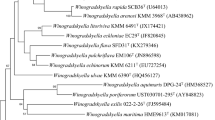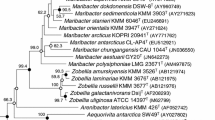Abstract
A novel bacterial strain, designated WS-MY5T, capable of degrading a variety of polysaccharides was isolated from a brown algae (Undaria pinnatifida) reservoir at Wando in the South Sea, South Korea. Strain WS-MY5T was found to grow optimally at 30 °C, at pH 7.0–7.5 and in the presence of 2 % (w/v) NaCl. A neighbour-joining phylogenetic tree based on 16S rRNA gene sequences showed that strain WS-MY5T falls within the clade comprising Winogradskyella species, clustering with the type strains of Winogradskyella pacifica, Winogradskyella arenosi, Winogradskyella rapida and Winogradskyella thalassocola, with which it exhibited 16S rRNA gene sequence similarity values of 97.3–98.8 %. It exhibited sequence similarity values of 93.0–96.2 % to the type strains of the other recognized Winogradskyella species. Strain WS-MY5T was found to contain MK-6 as the predominant menaquinone and anteiso-C15:0, iso-C15:0, iso-C15:0 3-OH, iso-C17:0 3-OH and iso-C15:1 G as the major fatty acids. The major polar lipids of strain WS-MY5T were identified as phosphatidylethanolamine, two unidentified lipids and two unidentified aminolipids. The DNA G+C content of strain WS-MY5T was determined to be 33.2 mol% and its DNA–DNA relatedness values with the type strains of W. pacifica, W. arenosi, W. rapida and W. thalassocola were in the range 16–28 %. Differential phenotypic properties, together with its phylogenetic and genetic distinctiveness, enabled strain WS-MY5T to be differentiated from the recognized Winogradskyella species. On the basis of the data presented here, strain WS-MY5T is considered to represent a novel species of the genus Winogradskyella, for which the name Winogradskyella undariae sp. nov. is proposed. The type strain is WS-MY5T (=KCTC 32261T=CCUG 63832T).

Similar content being viewed by others
References
Barrow GI, Feltham RKA (1993) Cowan and steel’s manual for the identification of medical bacteria, 3rd edn. Cambridge University Press, Cambridge
Bernardet JF (2011) Family I. Flavobacteriaceae Reichenbach 1992. In: Krieg NR, Ludwig W, Whitman WB, Hedlund BP, Paster BJ, Staley JT, Ward N, Brown D, Parte A (eds) Bergey’s manual of systematic bacteriology, Vol. 4. Springer, Berlin, pp 106–111
Bernardet JF, Nakagawa Y, Holmes B (2002) Proposed minimal standards for describing new taxa of the family Flavobacteriaceae and emended description of the family. Int J Syst Evol Microbiol 52:1049–1070
Bowman JP (2000) Description of Cellulophaga algicola sp. nov., isolated from the surfaces of Antarctic algae, and reclassification of Cytophaga uliginosa (ZoBell and Upham 1944) Reichenbach 1989 as Cellulophaga uliginosa comb. nov. Int J Syst Evol Microbiol 50:1861–1868
Bruns A, Rohde M, Berthe-Corti L (2001) Muricauda ruestringensis gen. nov., sp. nov., a facultatively anaerobic, appendaged bacterium from German North Sea intertidal sediment. Int J Syst Evol Microbiol 51:1997–2006
Euzéby JP (1997) List of Bacterial Names with Standing in Nomenclature: a folder available on the Internet. Int J Syst Bacteriol 47:590-592 (List of Prokaryotic names with Standing in Nomenclature. Last full update: April 13, 2013. URL: http://www.bacterio.cict.fr/)
Ezaki T, Hashimoto Y, Yabuuchi E (1989) Fluorometric deoxyribonucleic acid-deoxyribonucleic acid hybridization in microdilution wells as an alternative to membrane filter hybridization in which radioisotopes are used to determine genetic relatedness among bacterial strains. Int J Syst Bacteriol 39:224–229
Ivanova EP, Christen R, Gorshkova NM, Zhukova NV, Kurilenko VV, Crawford RJ, Mikhailov VV (2010) Winogradskyella exilis sp. nov., isolated from the starfish Stellaster equestris, and emended description of the genus Winogradskyella. Int J Syst Evol Microbiol 60:1577–1580
Kim SB, Nedashkovskaya OI (2010) Winogradskyella pacifica sp. nov., a marine bacterium of the family Flavobacteriaceae. Int J Syst Evol Microbiol 60:1948–1951
Komagata K, Suzuki KI (1987) Lipid and cell wall analysis in bacterial systematics. Methods Microbiol 19:161–207
Lányí B (1987) Classical and rapid identification methods for medically important bacteria. Methods Microbiol 19:1–67
Lau SCK, Tsoi MMY, Li X, Plakhotnikova I, Dobretsov S, Lau KWK, Wu M, Wong PK, Pawlik JR, Qian PY (2005) Winogradskyella poriferorum sp nov., a novel member of the family Flavobacteriaceae isolated from a sponge in the Bahamas. Int J Syst Evol Microbiol 55:1589–1592
Lee SY, Park S, Oh TK, Yoon JH (2012) Winogradskyella aquimaris sp. nov., isolated from seawater. Int J Syst Evol Microbiol 62:1814–1818
Leifson E (1963) Determination of carbohydrate metabolism of marine bacteria. J Bacteriol 85:1183–1184
Minnikin DE, Patel PV, Alshamaony L, Goodfellow M (1977) Polar lipid composition in the classification of Nocardia and related bacteria. Int J Syst Bacteriol 27:104–117
Minnikin DE, O’Donnell AG, Goodfellow M, Alderson G, Athalye M, Schaal A, Parlett JH (1984) An integrated procedure for the extraction of bacterial isoprenoid quinones and polar lipids. J Microbiol Methods 2:233–241
Nedashkovskaya OI, Kim SB, Han SK, Snauwaert C, Vancanneyt M, Swings J, Kim KO, Lysenko AM, Rohde M, Frolova GM, Mikhailov VV, Bae KS (2005) Winogradskyella thalassocola gen. nov., sp. nov., Winogradskyella epiphytica sp. nov. and Winogradskyella eximia sp. nov., marine bacteria of the family Flavobacteriaceae. Int J Syst Evol Microbiol 55:49–55
Nedashkovskaya OI, Vancanneyt M, Kim SB, Zhukova NV (2009) Winogradskyella echinorum sp. nov., a marine bacterium of the family Flavobacteriaceae isolated from the sea urchin Strongylocentrotus intermedius. Int J Syst Evol Microbiol 59:1465–1468
Nedashkovskaya OI, Kukhlevskiy AD, Zhukova NV (2012) Winogradskyella ulvae sp. nov., a novel epiphyte of a Pacific seaweed and emended descriptions of the genus Winogradskyella and Winogradskyella thalassocola, Winogradskyella echinorum, Winogradskyella exilis and Winogradskyella eximia. Int J Syst Evol Microbiol 62:1450–1456
Pinhassi J, Nedashkovskaya OI, Hagström Å, Vancanneyt M (2009) Winogradskyella rapida sp. nov., isolated from protein-enriched seawater. Int J Syst Evol Microbiol 59:2180–2184
Reichenbach H (1992) The order Cytophagales. In: Balows A, Trüper HG, Dworkin M, Harder W, Schleifer KH (eds) The Prokaryotes. Springer, New York, pp 3631–3675
Romanenko LA, Tanaka N, Frolova GM, Mikhailov VV (2009) Winogradskyella arenosi sp. nov., a member of the family Flavobacteriaceae isolated from marine sediments from the Sea of Japan. Int J Syst Evol Microbiol 59:1443–1446
Sasser M (1990) Identification of bacteria by gas chromatography of cellular fatty acids. MIDI technical note 101. Microbial ID, Inc., Newark
Stackebrandt E, Goebel BM (1994) Taxonomic note: a place for DNA–DNA reassociation and 16S rRNA sequence analysis in the present species definition in bacteriology. Int J Syst Bacteriol 44:846–849
Tamaoka J, Komagata K (1984) Determination of DNA base composition by reverse-phase high-performance liquid chromatography. FEMS Microbiol Lett 25:125–128
Thompson JD, Higgins DG, Gibson TJ (1994) Clustal W: improving the sensitivity of progressive multiple sequence alignment through sequence weighting, position-specific gap penalties and weight matrix choice. Nucleic Acids Res 22:4673–4680
Wayne LG, Brenner DJ, Colwell RR, Grimont PAD, Kandler O, Krichevsky MI, Moore LH, Moore WEC, Murray RGE et al (1987) International Committee on Systematic Bacteriology. Report of the ad hoc committee on reconciliation of approaches to bacterial systematics. Int J Syst Bacteriol 37:463–464
Yoon JH, Lee SY (2012) Winogradskyella multivorans sp. nov., a polysaccharide-degrading bacterium isolated from seawater of an oyster farm. Antonie Van Leeuwenhoek 102:231–238
Yoon JH, Kim H, Kim SB, Kim HJ, Kim WY, Lee ST, Goodfellow M, Park YH (1996) Identification of Saccharomonospora strains by the use of genomic DNA fragments and rRNA gene probes. Int J Syst Bacteriol 46:502–505
Yoon JH, Lee ST, Park YH (1998) Inter- and intraspecific phylogenetic analysis of the genus Nocardioides and related taxa based on 16S rDNA sequences. Int J Syst Bacteriol 48:187–194
Yoon JH, Kang KH, Park YH (2003) Psychrobacter jeotgali sp. nov., isolated from jeotgal, a traditional Korean fermented seafood. Int J Syst Evol Microbiol 53:449–454
Yoon BJ, Byun HD, Kim JY, Lee DH, Kahng HY, Oh DC (2011) Winogradskyella lutea sp. nov., isolated from seawater, and emended description of the genus Winogradskyella. Int J Syst Evol Microbiol 61:1539–1543
Yoon JH, Kang SJ, Lee SY (2012) Salinimonas lutimais sp. nov., a polysaccharide-degrading bacterium isolated from a tidal flat. Antonie Van Leeuwenhoek 102:803–810
Acknowledgments
This work was supported by a grant from the National Institute of Biological Resources (NIBR), funded by the Ministry of Environment (MOE) and the Program for Collection, Management and Utilization of Biological Resources and BK 21 program from the Ministry of Education, Science and Technology (MEST) of the Republic of Korea.
Author information
Authors and Affiliations
Corresponding author
Additional information
The GenBank/EMBL/DDBJ accession number for the 16S rRNA gene sequence of strain WS-MY5T is KC261665.
Electronic supplementary material
Below is the link to the electronic supplementary material.
Rights and permissions
About this article
Cite this article
Park, S., Yoon, JH. Winogradskyella undariae sp. nov., a member of the family Flavobacteriaceae isolated from a brown algae reservoir. Antonie van Leeuwenhoek 104, 619–626 (2013). https://doi.org/10.1007/s10482-013-9968-3
Received:
Accepted:
Published:
Issue Date:
DOI: https://doi.org/10.1007/s10482-013-9968-3




